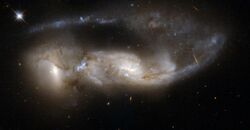Astronomy:NGC 6622
| NGC 6622 | |
|---|---|
 Hubble Space Telescope image of NGC 6622 (left) and NGC 6621 (center) | |
| Observation data (J2000 epoch) | |
| Constellation | Draco |
| Right ascension | 18h 12m 59.50s[1] |
| Declination | +68° 21′ 19.0″[1] |
| Redshift | 0.02157±0.00013[1] |
| Distance | 313 Mly (96.0 Mpc)[1] |
| Apparent magnitude (V) | 15.0[1] |
| Characteristics | |
| Type | G'Sb[1] |
| Size | 219,000 ly |
| Apparent size (V) | .955 x .832[1] |
| Notable features | N/A |
| Other designations | |
| KCPG 534A,[1] PGC 61579,[1] KPG 534b,[1] LEDA 61579,[1] UGC 11175 S,[1] UZC J181259.8+682114[1] | |
NGC 6622 is an interacting spiral galaxy in the constellation Draco.[1] It is located around 313 million light-years away, and it was discovered by Edward D. Swift and Lewis A. Swift on June 2, 1885.[1][2] NGC 6622 interacts with NGC 6621, with their closest approach having taken place about 100 million years before the moment seen now.[3] NGC 6622 and NGC 6621 are included in the Atlas of Peculiar Galaxies as Arp 81 in the category "spiral galaxies with large high surface brightness companions".[4][5]
NGC 6622 is the smaller of the two, and is a very disturbed galaxy.[5][1] The encounter has left NGC 6622 very deformed, as it was once a spiral galaxy.[6][1] The collision has also triggered extensive star formation between the two galaxies.[7] The most intense star formation takes place in the region between the two nuclei, where a large population of luminous clusters, also known as super star clusters, has been observed. At this region is observed the most tidal stress.[6][2] The brightest and bluest clusters are less than 100 million years old,[2] with the youngest being less than 10 million years old.[4] The side of the galaxy further from the companion features noticeably less star formation activity.[3][1][7]
References
- ↑ 1.00 1.01 1.02 1.03 1.04 1.05 1.06 1.07 1.08 1.09 1.10 1.11 1.12 1.13 1.14 1.15 1.16 1.17 "By Name | NASA/IPAC Extragalactic Database". http://ned.ipac.caltech.edu/byname?objname=NGC+6622&hconst=67.8&omegam=0.308&omegav=0.692&wmap=4&corr_z=1.
- ↑ 2.0 2.1 2.2 "NGC 6622 - Spiral Galaxy in Draco | TheSkyLive.com". https://theskylive.com/sky/deepsky/ngc6622-object.
- ↑ 3.0 3.1 "NGC 6622 - Galaxy - SKY-MAP". http://www.wikisky.org/starview?object_type=2&object_id=25183.
- ↑ 4.0 4.1 information@eso.org. "NGC 6621, NGC 6622" (in en). https://www.spacetelescope.org/images/heic0810bd/.
- ↑ 5.0 5.1 "Check out what the @NASAHubble Space Telescope looked at on my birthday! #Hubble30" (in en). https://imagine.gsfc.nasa.gov/hst_bday/march-15.
- ↑ 6.0 6.1 "NGC 6621 and NGC 6622 | SkyCenter". https://skycenter.arizona.edu/astrophotography/ngc6621andngc6622.
- ↑ 7.0 7.1 Astronomy, Go. "NGC 6622 | galaxy in Draco | NGC List | GO ASTRONOMY" (in en-US). https://www.go-astronomy.com/ngc.php?ID=7058.
External links
- More about NGC 6622
 |

